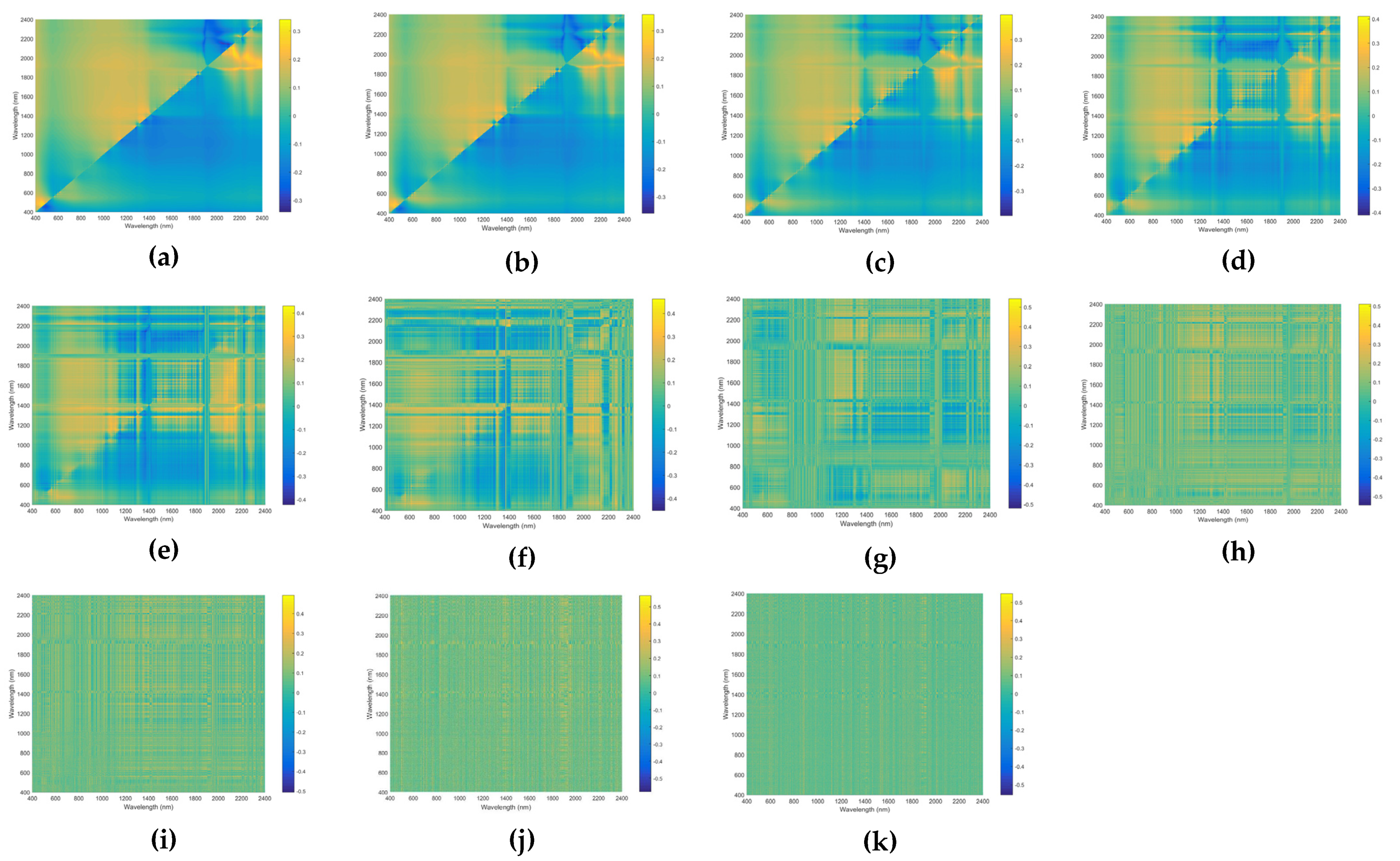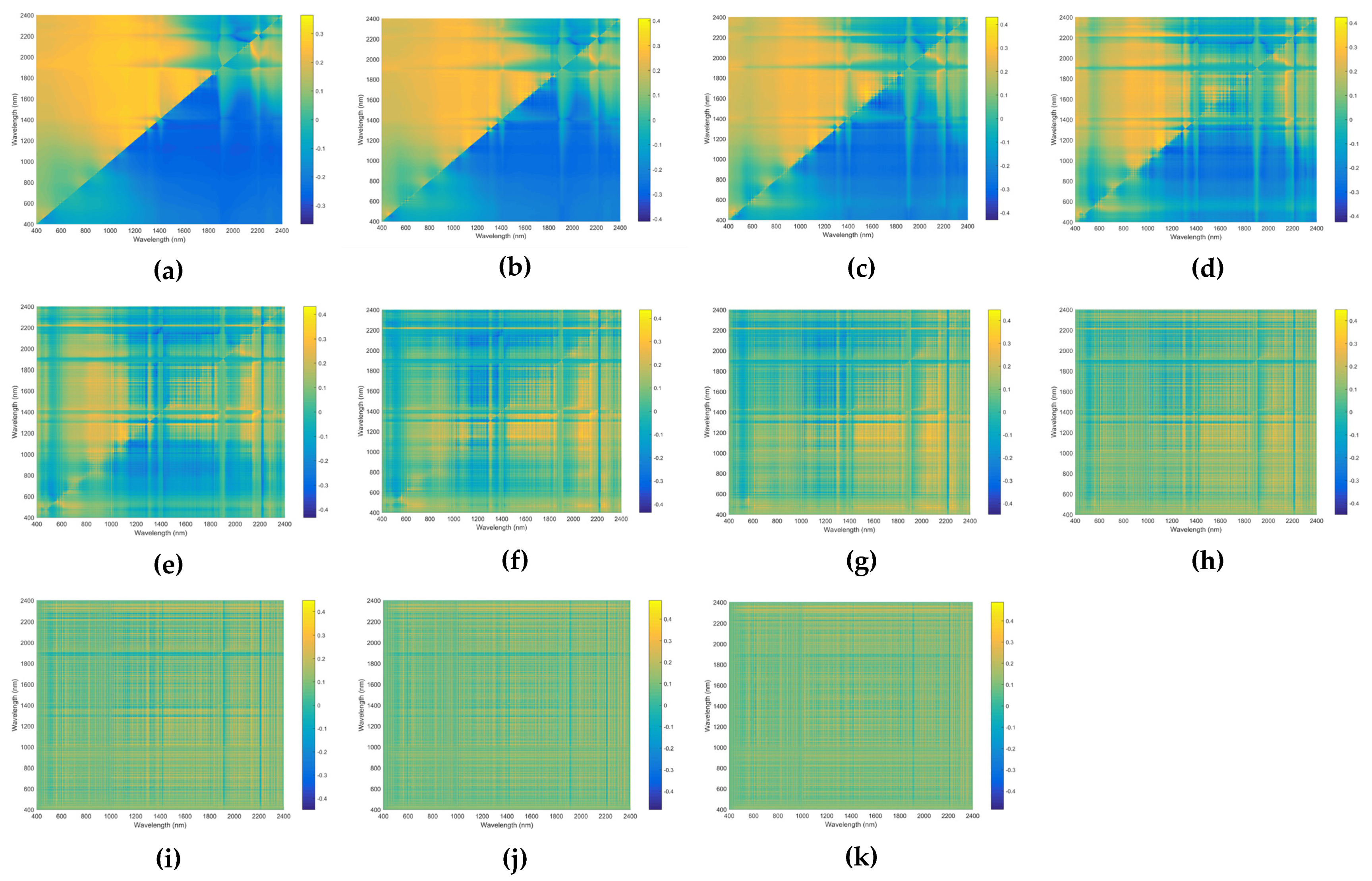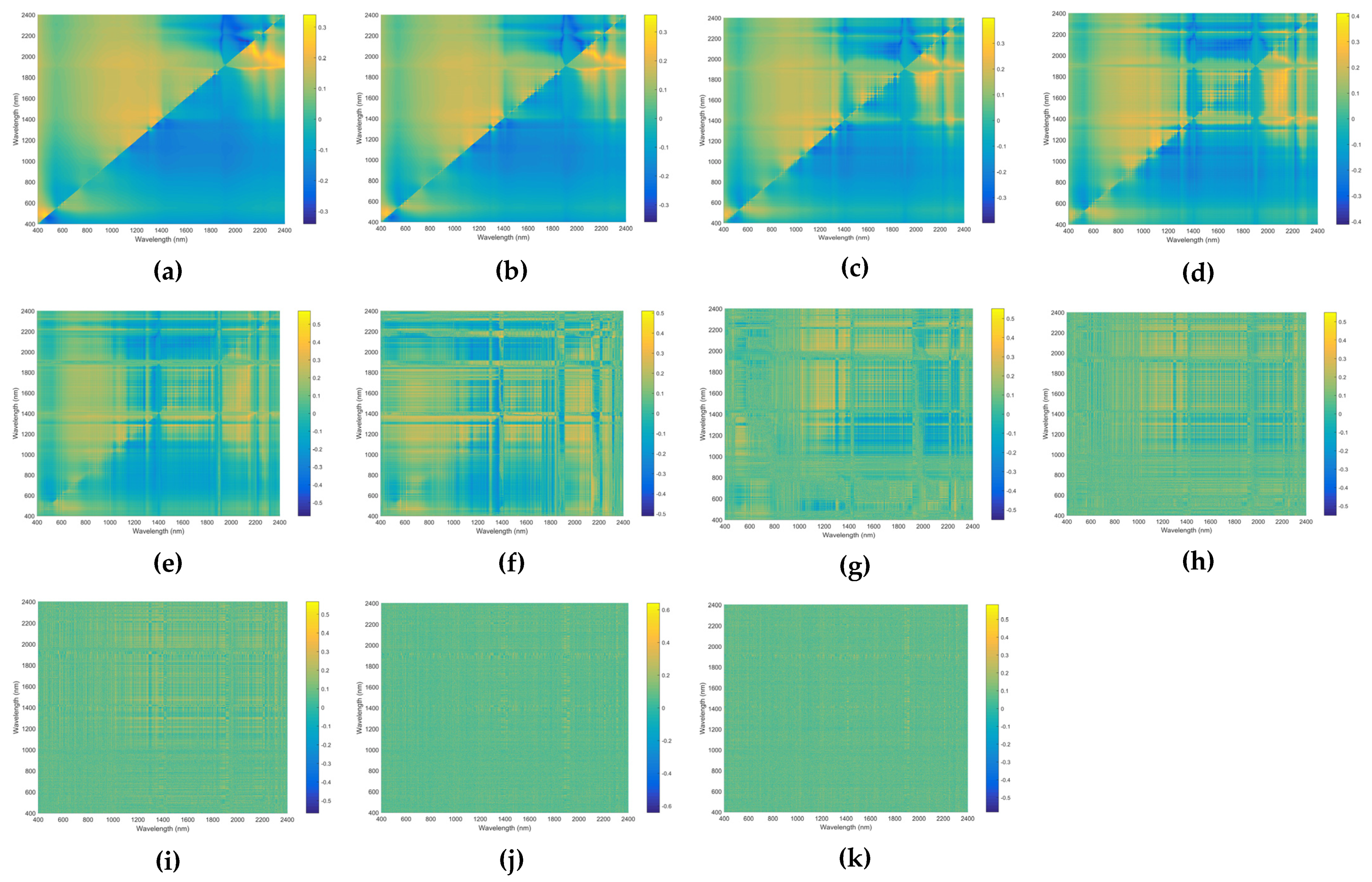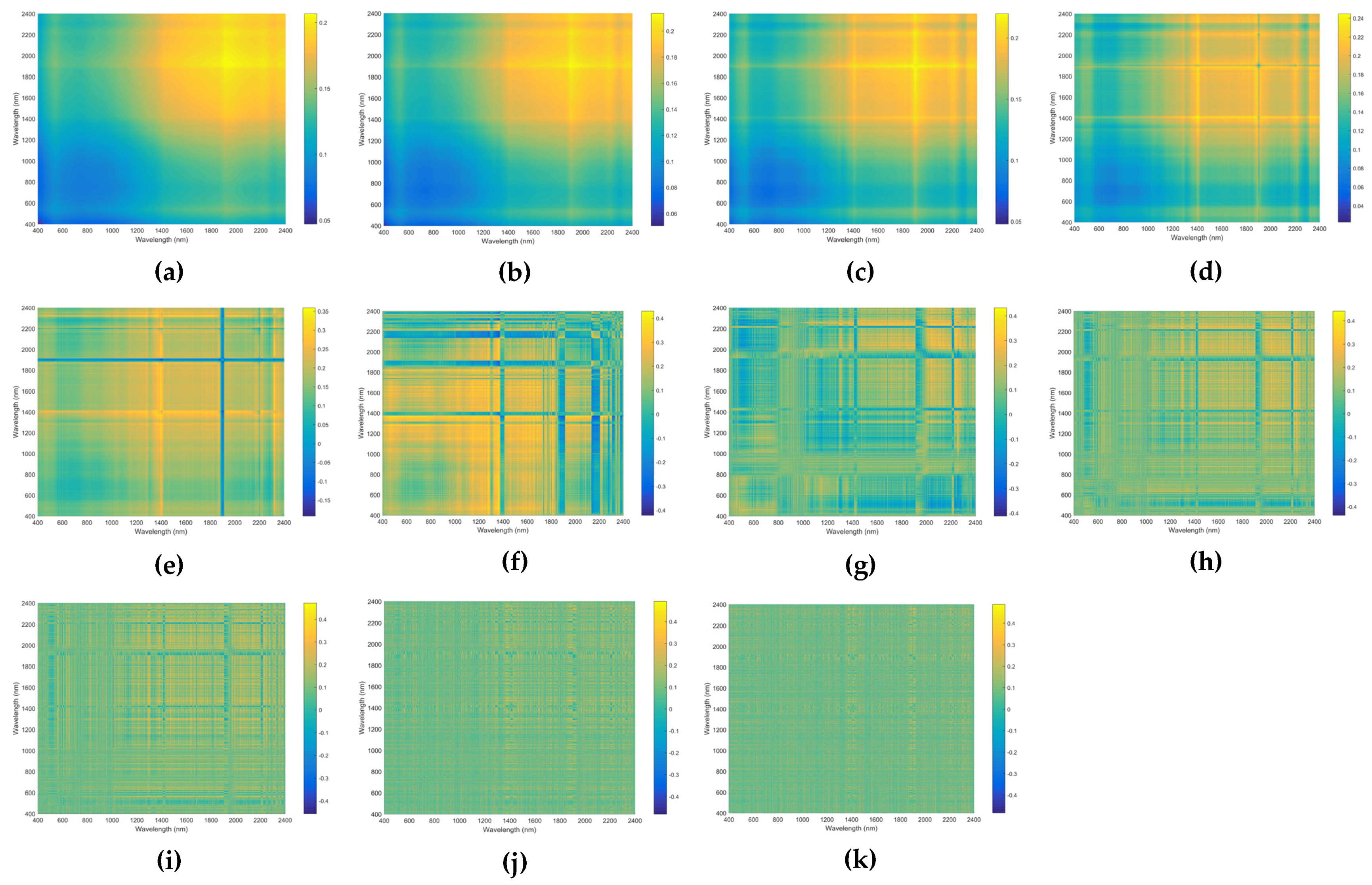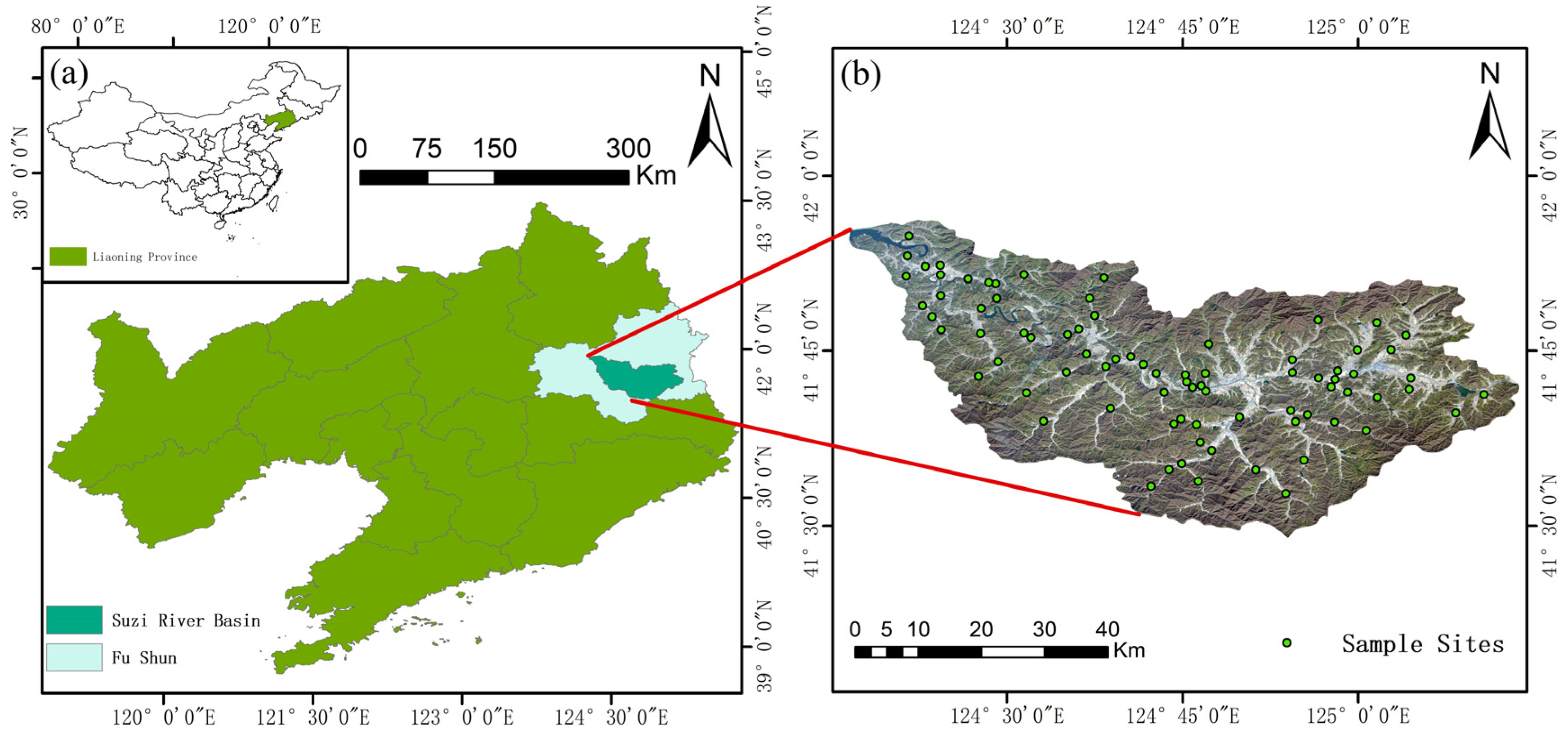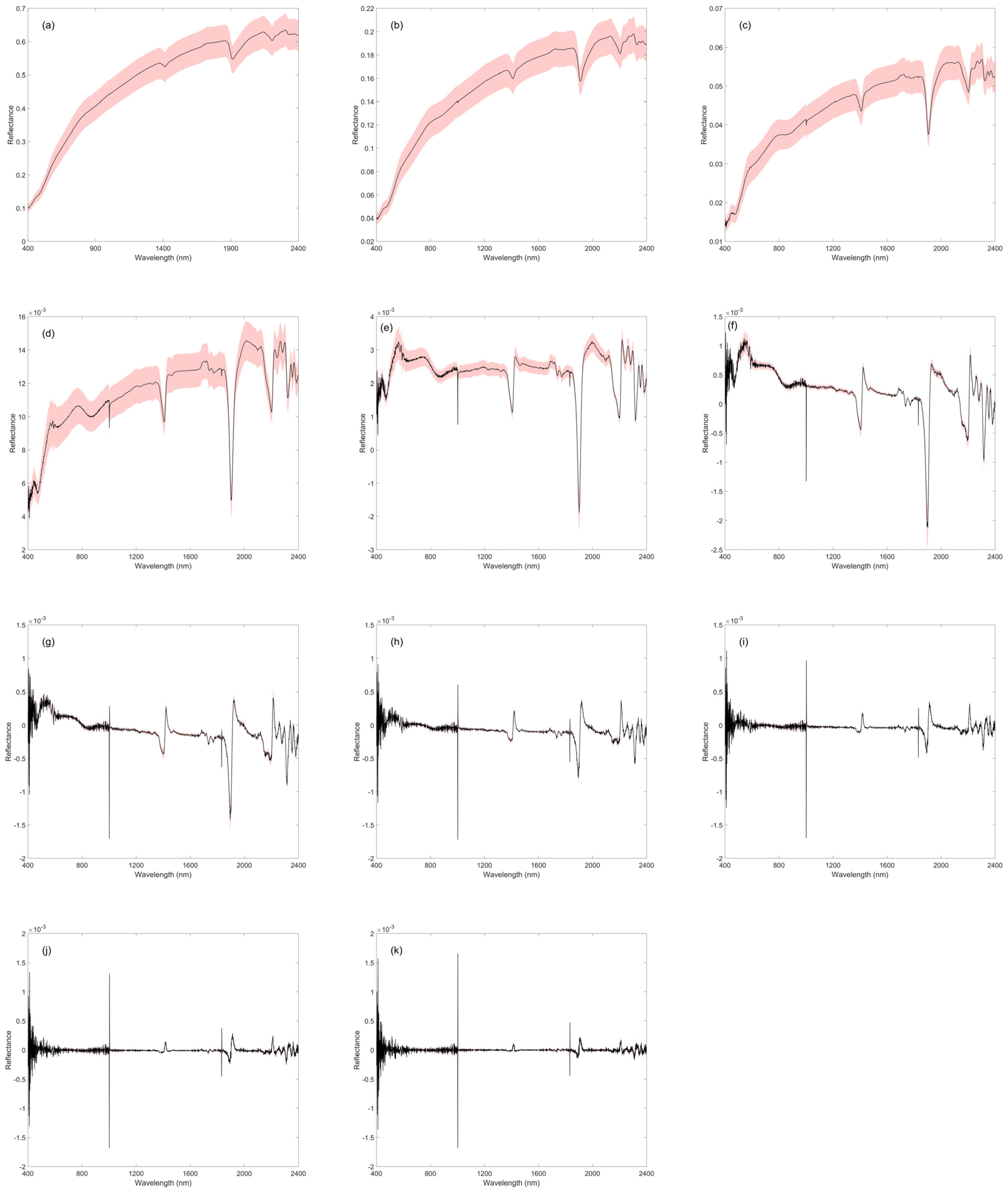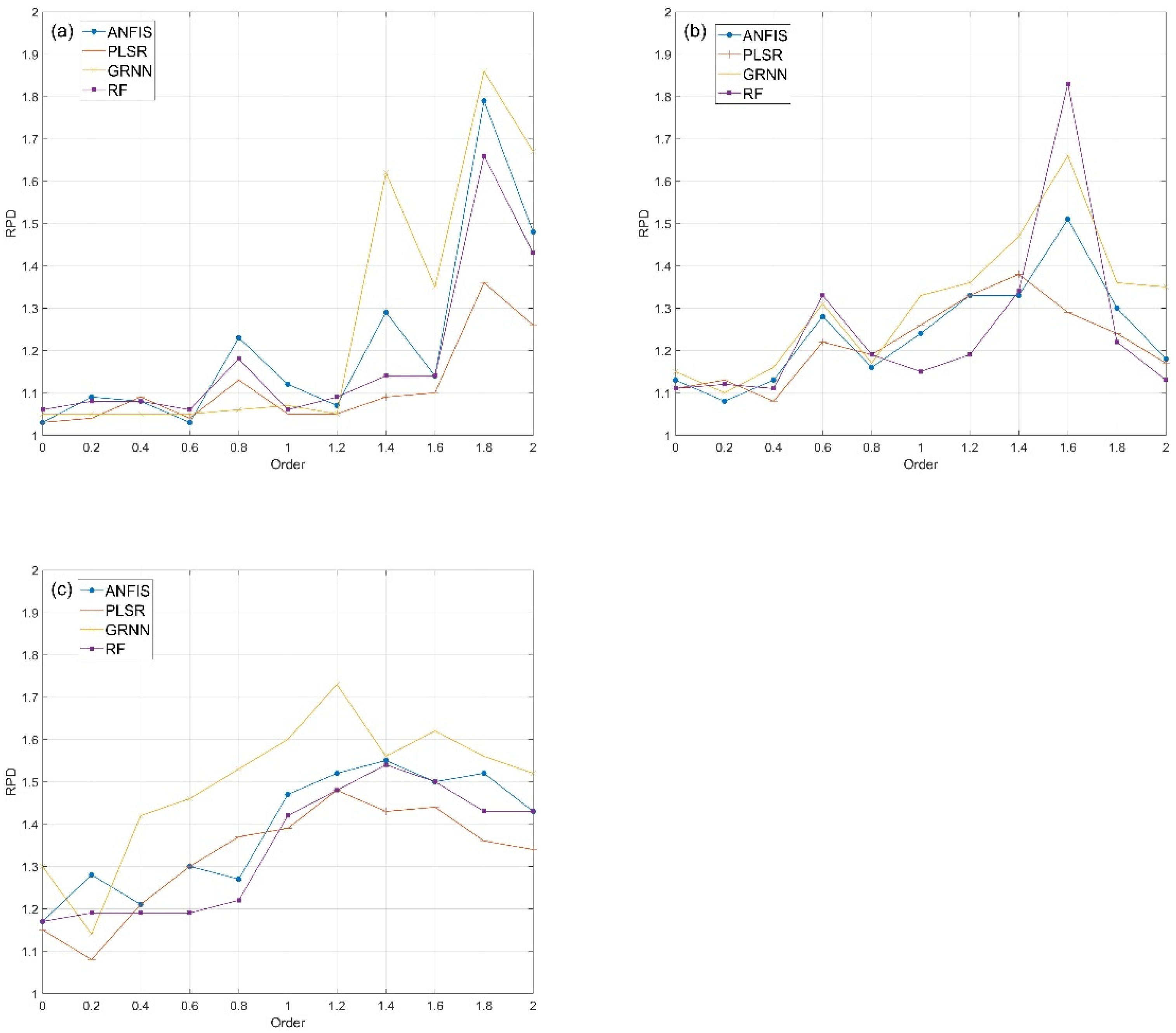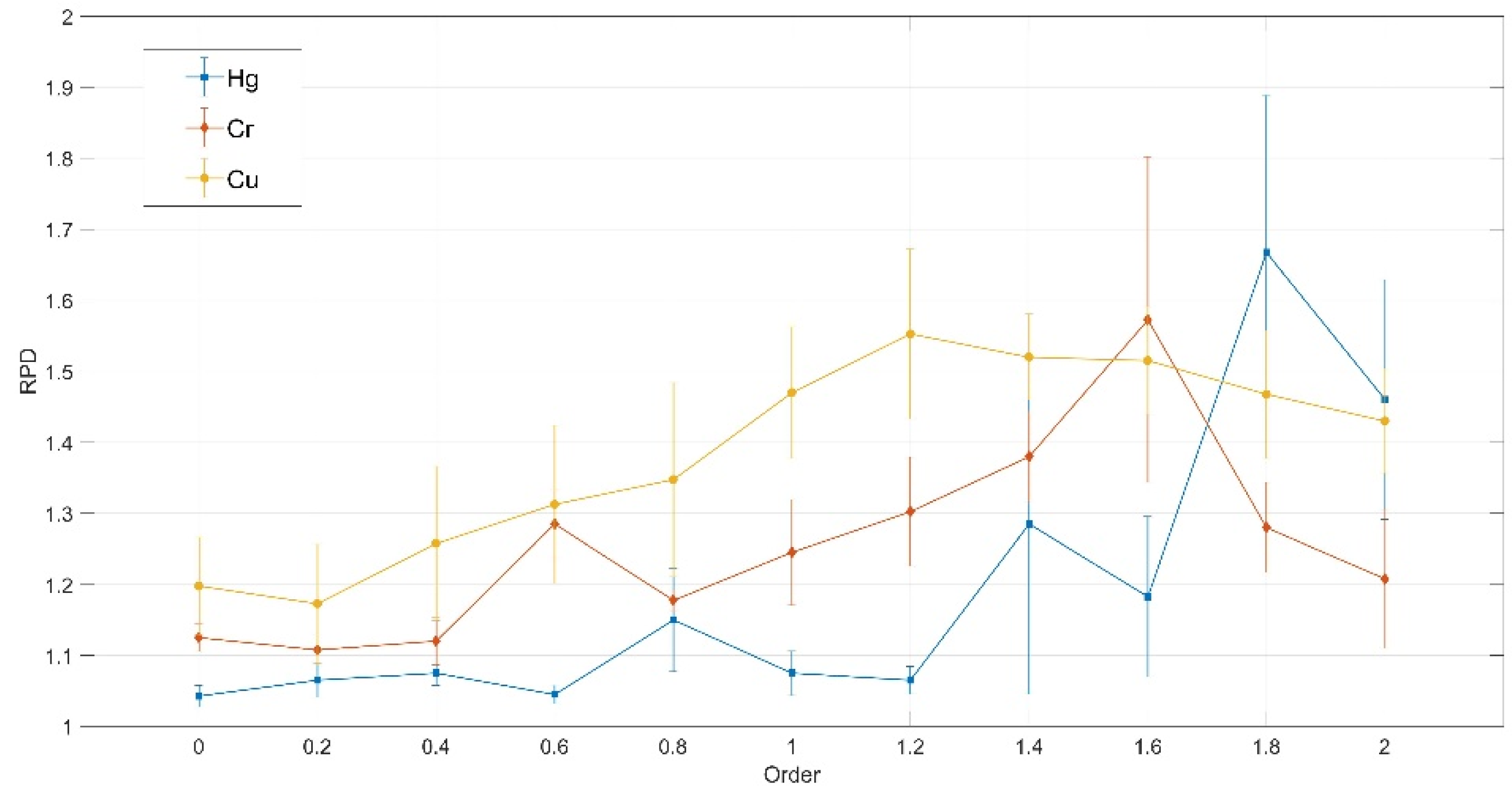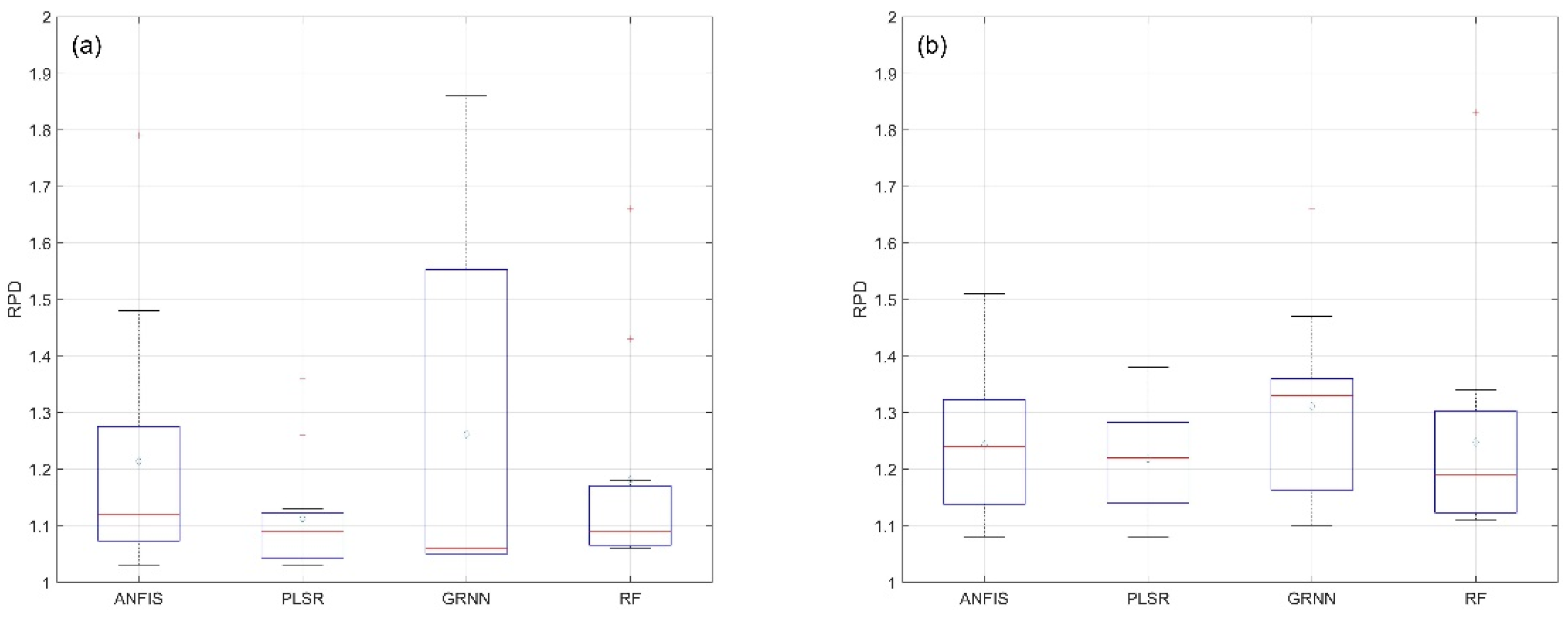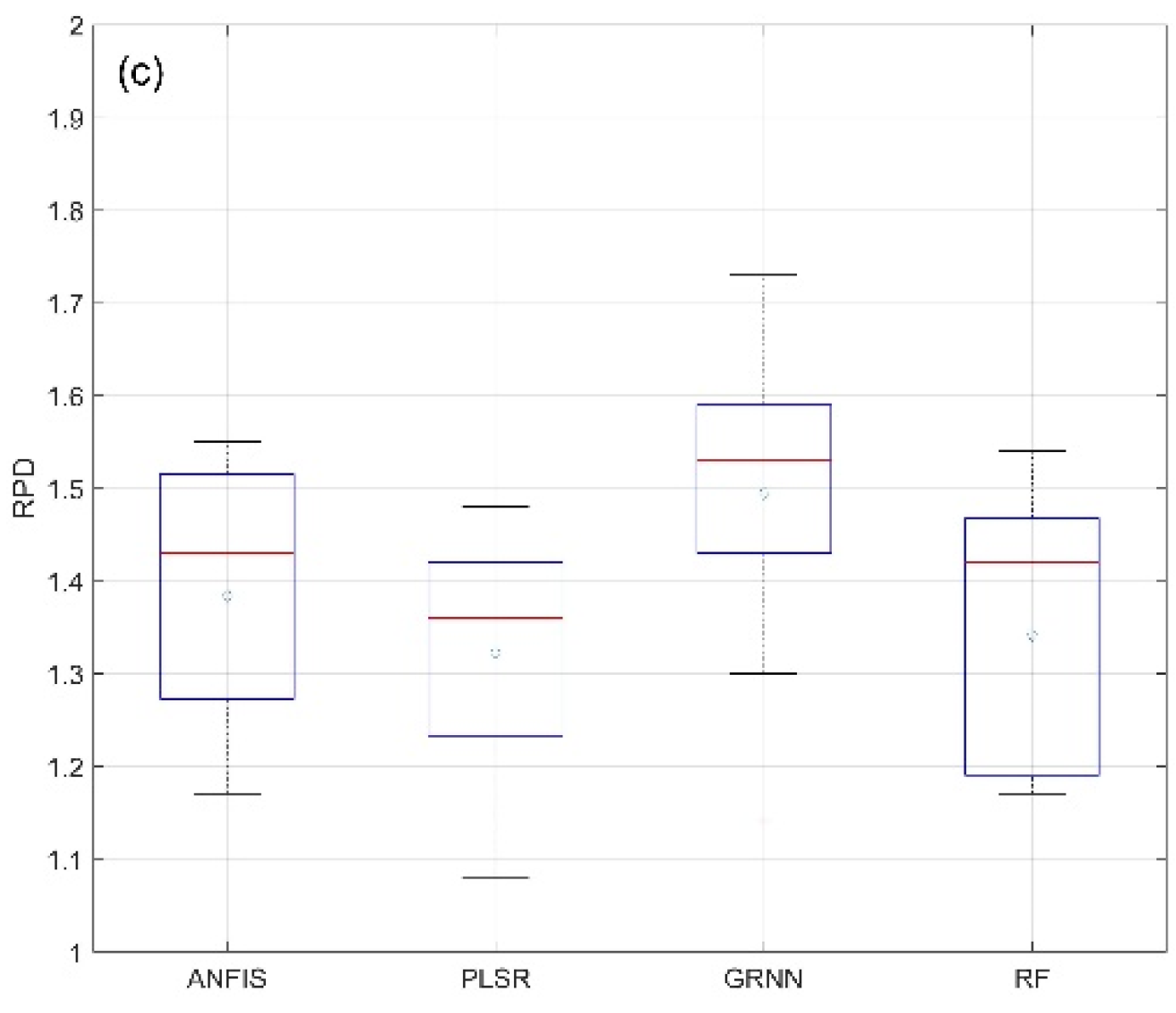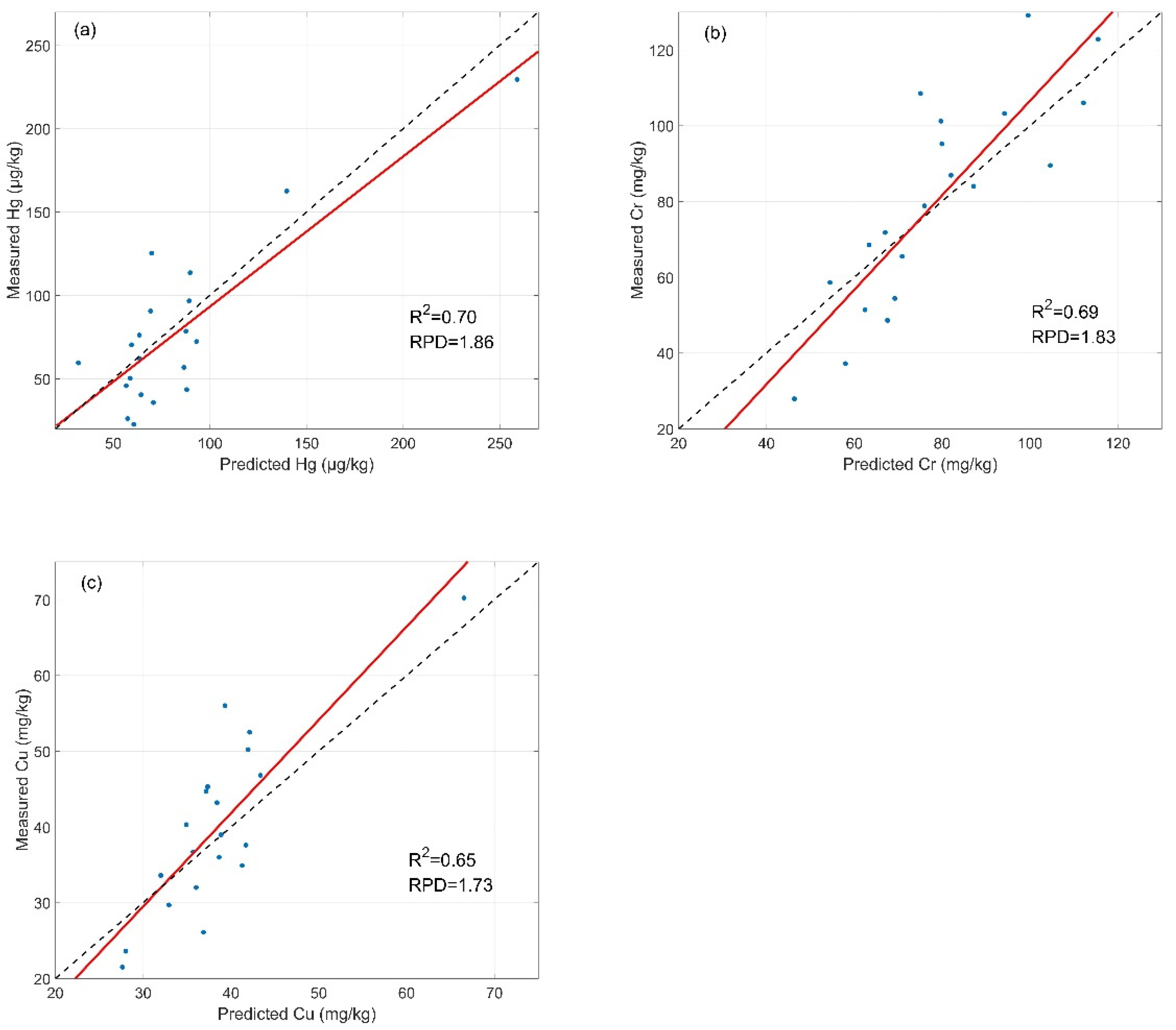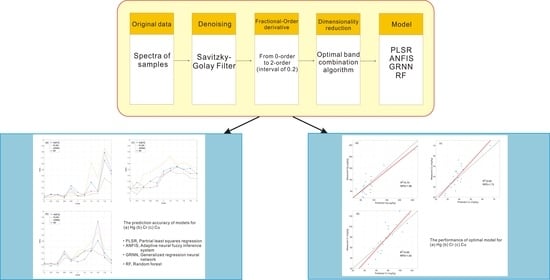1. Introduction
Soil contamination has increased significantly worldwide with the rapid development of industrialization and urbanization [
1,
2,
3]. Due to their contamination being covert, persistent and irreversible, heavy metals are among the most hazardous contamination types that threaten the health of animals and human beings throughout the food chain [
4,
5,
6,
7,
8]. Soil heavy metals, especially mercury (Hg), chromium (Cr), lead (Pb), cadmium (Cd) and copper (Cu), tend to be accumulated in soils because of anthropogenic activities and their own easy migration properties as common industrial pollutants [
9,
10,
11,
12,
13,
14]. Thus, it is crucial to closely monitor the concentration of heavy metals. However, the mechanisms of soil evolution are complex and difficult to understand [
15], and the soil properties may vary obviously on a small scale [
16]. Traditional field sampling is always accompanied by sample preparation and chemical analysis, which is difficult to apply widely [
17]. Alternatively, because of its low cost and environmental friendliness, visible and near-infrared (Vis-NIR) spectroscopy has been used as a viable alternative to laboratory analysis methods for soil quality assessment [
18,
19,
20,
21].
Affected by measuring environment, instrument errors or other reasons, spectra always obtain undesired side effects, such as spectral noises, baseline shift, and mixed overlapping peaks [
20,
22]. Spectral preprocessing techniques are utilized to reduce undesirable effects and accentuate spectral features [
21]. Spectral derivatives are able to eliminate baseline drift and separate overlapping spectra, thereby turning into a frequently used spectral preprocessing technique. The positive effect of first derivatives and second derivatives on heavy metal concentration estimation has been validated and reviewed by researchers [
20,
23,
24,
25]. Nevertheless, integer derivatives disregard the gradual variation in the spectrum in slit and curvature, which leads to the loss of subtle information. Fractional-order derivative (FOD) can refine the order of conventional derivatives. Until now, researchers only applied FOD to Vis-NIR spectroscopy estimation of Pb, Zn and Cr [
26,
27], and the effect of FOD on other heavy metals that tend to accumulate in soils has not been reported. In addition, as a key spectral preprocessing technique, spectral dimensionality reduction can reduce data redundancy and improve the accuracy of estimation [
28]. The optimal band combination algorithm can find the most suitable bands and generate an optimal combination through magnifying the correlation between dependent and independent variables [
23,
29]. The algorithm has been proved to be able to effectively eliminate the noise caused by second derivative [
23], whereas the improvement to FOD produced by the algorithm has not been explored yet.
Other than spectral preprocessing techniques, mathematical models also have great impacts on the Vis-NIR spectroscopy estimation of soil heavy metals [
30]. Commonly used mathematical models include multiple linear regression (MLR) [
31], partial least squares regression (PLSR) [
32], random forest (RF) [
27], support vector machine (SVM) [
33], and adaptive neural fuzzy inference system (ANFIS) [
34]. In previous studies, ANFIS and RF reported that they performed better than other models [
27,
34,
35]. As a kind of radial basis function neural network, the generalized regression neural network (GRNN) has excellent performance in anti-interference, the ability of autonomous learning and fast convergence speed [
36]. In other applications of mathematical models, it has been proved that GRNN can achieve similar or better performance compared with RF and ANFIS [
37,
38,
39,
40]. However, there is no study comparing the performance of GRNN, ANFIS, and RF in Vis-NIR spectroscopy estimation of heavy metals in soils.
The aim of the study was to explore the potential of using appropriate preprocessing techniques and mathematical models to improve Vis-NIR spectroscopy estimation accuracy of heavy metals in soils. Hence, we introduced FOD to highlight the hidden information of the spectrum, and assessed the effect of optimal band combination algorithm on FOD. PLSR, GRNN, ANFIS and RF were utilized to estimate the concentration of Hg, Cr and Cu in soils with the spectral indices produced by the optimal band combination algorithm. Additionally, the performances of the four mathematical models were compared in detail.
4. Discussion
In this study, the concentration of three heavy metals in most samples was below the risk screen value. However, most samples had Hg and Cr concentration that surpassed the local background value, and all samples had Cu concentration that surpassed the local background value. In unpolluted natural soils, the heavy metals are at trace concentrations [
69]. The enrichment of heavy metals indicates the ecological environment has been disturbed by anthropogenic activities [
70,
71]. This is related to industrial activities, especially the non-standard design of mine tailing ponds, which leads to the leakage of heavy metal elements.
In the study of spectral derivatives, some researchers have reported that the first derivative produced higher model accuracy than the second derivative when estimating heavy metals and soil organic matter [
72,
73,
74]. This phenomenon is related to the fact that the first derivative can enhance the spectral information while maintaining the continuity and integrity of spectral information, whereas the second derivative introduces additional spectral noise [
20,
72]. In
Figure 2, the second derivative spectrum fluctuated too frequently, indicating that the spectral information was disturbed by spectral noise. However, in this study, the accuracy of models using the first derivative was similar to those using the second derivative in the estimation of Cr and Cu, and the accuracy of models using the second derivative was higher than those using the first derivative in the estimation of Hg. How did this phenomenon happen in our experiment? After spectral derivatives, the spectra were processed by the optimal band combination algorithm. The algorithm selects the optimal bands, and carries on the mathematical transformation to the reflectance. In this process, the additional spectral noise caused by the high-order derivatives is removed. Furthermore, compared with low-order derivatives, high-order derivatives have the advantages of highlighting spectral information and separating the minor absorption peaks. Therefore, the accuracy of the models using the second derivative was similar to that of the first derivative, or even greatly improved. In addition to the removal of noise, the optimal band combination algorithm also has the ability to reduce the impact of irrelevant wavelength and cope with the overlapping absorption of soil components through considering wavelength interactions [
48,
75,
76]. According to the spectral indices counted in
Table 2,
Table 3 and
Table 4, a total of 19 wavelengths were selected from the spectra of three heavy metals, including 547 nm, 667 nm, 714 nm, 866 nm, 923 nm, 955 nm, 980 nm, 1011 nm, 1015 nm, 1129 nm, 1137 nm, 1173 nm, 1295 nm, 1562 nm, 1710 nm, 1969 nm, 2087 nm, 2342 nm, and 2346 nm. These wavelengths are close to the absorption characteristics of hematite, ferrihydrite, Fe
3+, goethite, illite, organic matter, N-H, C-H, and O-H stretch [
56,
77]. The spectral characteristics of soil organic matter (SOM) and clay are closely related to the spectral response of N-H, C-H and O-H covalent bonds [
78]. This is consistent with the absorption characteristics obtained. According to previous studies, due to the strong absorption capacity of SOM, iron oxides and clay, the Vis-NIR spectroscopy monitoring of heavy metals is through association with proxies (i.e., SOM, iron and clay) [
79,
80]. Therefore, Vis-NIR spectroscopy estimation for Hg, Cr and Cu can be performed indirectly through these components or functional groups.
It is obvious that the spectra after the first derivative are quite different from those after the second derivative, and most of the subtle information changes are ignored.
Table 2,
Table 3 and
Table 4 demonstrate how the correlation of spectral indices varies with the order of spectral derivatives. The characteristic bands of spectral indices have great variation in 1-order and 2-order. This showed that conventional spectral derivatives lost certain useful spectral information, and this loss of information is amplified by the optimal band combination algorithm. Additionally, the correlation coefficient of most spectral indices achieved the highest value between 1.2-order and 1.8-order, suggesting that FOD is able to detect more detailed spectral features compared with conventional spectral derivatives.
Figure 3 shows the variation in model accuracy after FOD and the four modeling methods. It can be seen that the models using FOD achieved better accuracy in the estimation of three heavy metals, regardless of the modeling method used, and the optimal models appeared at the 1.8-order, 1.6-order, and 1.2-order. Consistent with the optimal models, the maximum values of mean RPD for the models were also achieved at 1.8-order, 1.6-order and 1.2-order, which corresponded to Hg, Cr and Cu, respectively (
Figure 4). This further indicates the advantages of high-order derivatives and the optimal band combination algorithm. High-order derivatives can highlight the hidden features in the spectrum, and the additional noise introduced by the high-order derivatives can be removed by the optimal band combination algorithm. The incorporation of the optimal band combination algorithm and FOD can enhance the estimation accuracy of heavy metals.
In the study, the ANFIS, PLSR, GRNN, and RF methods were applied to compare the estimation accuracy of the three heavy metal concentrations. According to
Table 8,
Table 9 and
Table 10, the model accuracy listed in
Table 5,
Table 6 and
Table 7 is influenced not only by FOD but also by modeling methods, and the more intuitive comparison of modeling methods is shown by boxplots (
Figure 5). PLSR obtained the lowest mean value of model accuracy in the estimation of the three heavy metals. PLSR is only suitable for linear relationships [
16,
74,
81]. However, there are various external or internal factors that can enhance the non-linear relationships between the Vis-NIR spectrum and soil components, such as measurement environment and characteristics of components [
82,
83]. Thus, compared with PLSR, the other three modeling methods are more suitable for estimation of heavy metals in soils due to their substantial non-linear prediction ability. Among ANFIS, RF and GRNN, GRNN showed the best performance in the estimation of heavy metal concentration. The GRNN has excellent capacity on non-linear mapping and learning speed; in particular, it has greater advantages in mapping unstable data to more accurate output [
39,
40,
66]. Additionally, the range of target property is the fundamental factor of model accuracy [
84]. The CV values reached 62.35%, 34.45%, and 28.58% for Hg, Cr, and Cu (
Table 1), indicating heavy metal concentration in this study varied in a wide range with a high degree of dispersion. This is related to the outperformance of the models using GRNN.
In addition, the study also has some limitations. When dividing the dataset, more sample selection methods should be considered to enhance the stability of the experiment. For example, stratified sampling and Kennard–Stone sampling can be used to avoid taking the output property into account [
85]. In the experiment, due to the high CV values of Hg, Cr and Cu in the samples, the models did not achieve high accuracy [
84]. The representativeness of soil samples is significant for the estimation of heavy metals in soils using Vis-NIR spectroscopy. In future studies, this should be avoided by taking more soil samples. Furthermore, because of the optimal band combination algorithm, only five features were taken as input variables. This is related to the failure of RF to achieve better performance. Additionally, it is necessary to note the potential limitation of GRNN. It cannot ignore irrelevant inputs, thereby it is not likely to be suitable enough if existing more than five or six non-redundant inputs [
66]. Thus, methods other than GRNN should be considered when using the full spectrum for modeling. The optimal results can be obtained by combining GRNN with appropriate dimensionality reduction methods, such as the optimal band combination algorithm.
The study of soil components is a multi-factor problem [
86]. In the particular area, the lack of high-resolution spatial variability data always leads to substantial errors [
87]. Using Vis-NIR spectroscopy can effectively reduce the workload of sampling, so as to obtain more spatial variability data. Thus, the incorporation of FOD, the optimal band combination algorithm and GRNN is a significant method for rapid evaluation of heavy metal concentration in agricultural soils.
5. Conclusions
In this study, the potential of Vis-NIR spectroscopy to estimate the concentration of Hg, Cr, and Cu in soils was evaluated. Through the incorporation of FOD, the optimal band combination algorithm and modeling methods, the optimal models of Hg, Cr, and Cu were obtained. The optimal validation accuracy of Hg (R2 = 0.70, RPD = 1.86) and Cu (R2 = 0.65, RPD = 1.73) was achieved by the 1.8-order and 1.2-order reflectance GRNN model, and the optimal estimated accuracy of Cr (R2 = 0.69, RPD = 1.83) was achieved by the 1.6-order reflectance RF model. The optimal band combination algorithm is able to avoid the influence of spectral noise caused by high-order derivatives. Compared with conventional derivatives, FOD can identify the subtler spectral characteristics of heavy metals due to its gradual change in treatment of the spectrum. The high-order FOD is able to highlight hidden information and the separate minor absorbing peak. In addition, the incorporation of the optimal band combination algorithm and high-order FOD can further mine spectral information, ignoring noise. The optimal performance was achieved by the 1.8-order, 1.6-order, and 1.2-order spectra for Hg, Cr, and Cu, correspondingly. For estimation of heavy metals in soils, the modeling methods with the ability to solve non-linear problems are more suitable. When using the appropriate dimensionality reduction method, GRNN provides an obvious improvement to the estimation accuracy of all studied heavy metals compared to ANFIS, PLSR, and RF. Thus, the incorporation of the optimal band combination algorithm, FOD, and GRNN for the rapid spectral estimation of Hg, Cr, and Cu concentration was proven to be feasible. Additionally, this study is vital for the application of Vis-NIR spectroscopy technology to the investigation of other heavy metal contaminants in soils. In the future, we will conduct more studies to detect the influence of GRNN and FOD on Vis-NIR spectroscopy estimation of soil heavy metals through large soil spectral libraries.
